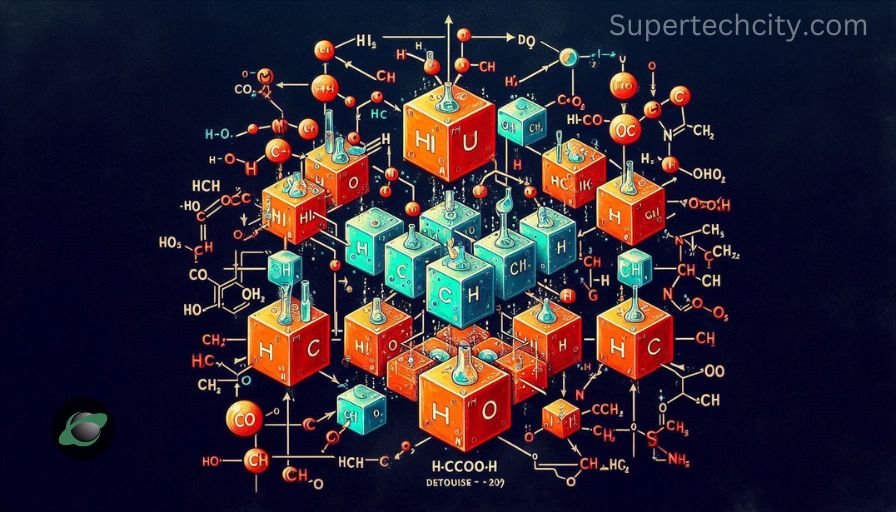Chemical reactions form the backbone of various processes in science and industry. One such reaction involves the combination of formic acid (HCOOH) and a methyl group (CH2) to form water (H2O). This article delves into the fundamentals of this reaction, its chemical implications, and potential applications.
What is HCOOH + CH2 = H2O?
This reaction showcases the interplay between formic acid (HCOOH), a simple carboxylic acid, and a methyl group (CH2). The equation highlights the formation of water (H2O) as a byproduct. Understanding this chemical equation provides insight into broader organic and inorganic reaction mechanisms.
Key Components of the Reaction
- HCOOH (Formic Acid):
- Simplest carboxylic acid with a single carbon atom.
- Known for its role in biological processes and industrial applications.
- CH2 (Methylene Group):
- A part of larger organic structures.
- Plays a crucial role in organic synthesis.
- H2O (Water):
- Universal solvent and essential byproduct in many reactions.
The Reaction Process
Breaking Down the Equation
- Reactants:
- HCOOH contributes the carboxylic group (-COOH).
- CH2 introduces the necessary methyl group.
- Chemical Interaction:
- The interaction involves electron transfer and bond formation.
- Resulting bonds lead to the formation of water as a byproduct.
- Products:
- Final output includes a newly formed organic compound alongside H2O.
Applications of the Reaction
Industrial Applications
- Chemical Synthesis: Used in creating intermediates for pharmaceuticals and fine chemicals.
- Energy Storage: Plays a role in hydrogen storage research for fuel cells.
Biological Significance
- Metabolism Studies: Helps in understanding biochemical pathways where formic acid plays a role.
Research and Development
- Catalyst Design: Invaluable in developing catalysts for organic reactions.
- Green Chemistry: Promotes sustainable practices by minimizing waste through water production.
Chemical Properties of HCOOH, CH2, and H2O
| Compound | Molecular Formula | Properties | Uses |
|---|---|---|---|
| Formic Acid | HCOOH | Corrosive, pungent smell | Leather production, food preservatives |
| Methylene Group | CH2 | Reactive, unstable in isolation | Organic synthesis, polymer formation |
| Water | H2O | Universal solvent, high boiling point | Industrial processes, biological necessity |
Advantages of the Reaction
- Eco-Friendly: Water as a byproduct reduces environmental impact.
- Versatile Applications: Spans across industries like pharmaceuticals and materials science.
- Efficiency: High-yield reaction under optimized conditions.
Challenges and Considerations
- Reactivity Management: CH2’s high reactivity demands controlled conditions.
- Catalyst Dependence: Efficient catalysis is often necessary for practical applications.
- Purity of Reactants: Impurities in HCOOH or CH2 can affect reaction outcomes.
FAQs
What is HCOOH?
HCOOH, or formic acid, is the simplest carboxylic acid used in various industrial and biological processes.
What role does CH2 play in this reaction?
CH2 acts as a reactive intermediate, facilitating the formation of new organic compounds.
Why is water (H2O) a byproduct?
Water forms due to the removal of a hydroxyl group from HCOOH and a hydrogen atom during the reaction.
Are there industrial applications of this reaction?
Yes, this reaction is valuable in chemical synthesis, catalyst research, and green chemistry initiatives.
Is the reaction environmentally friendly?
Yes, the production of water as a byproduct ensures minimal environmental impact.
Conclusion
The reaction involving HCOOH + CH2 = H2O is a fascinating example of chemical interplay with significant scientific and industrial relevance. Its eco-friendly nature, coupled with wide-ranging applications, makes it a topic of interest in both research and practical fields. By understanding its components and implications, we can leverage this reaction for advancements in technology, chemistry, and sustainability.

